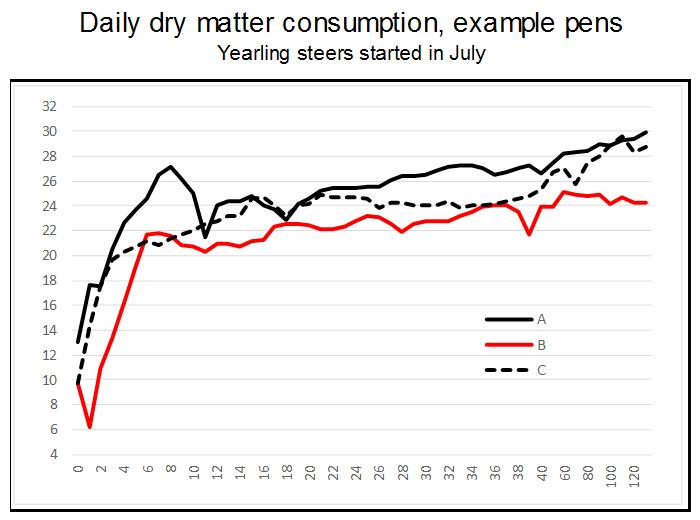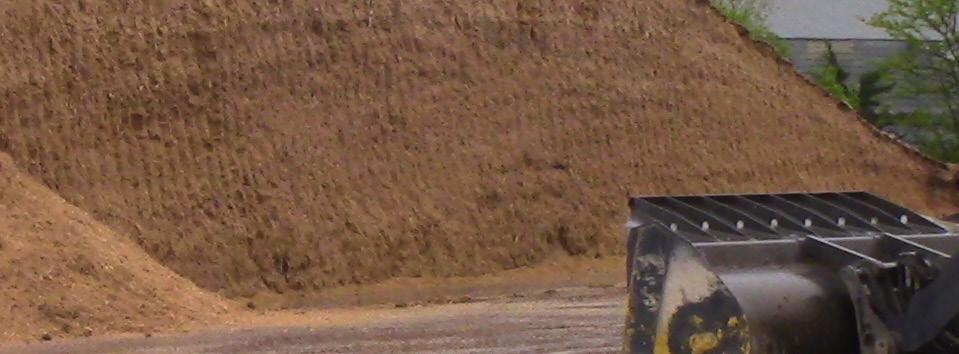
4 minute read
and Veterinary Feed Directives
dicted. Not all cattle of the same sex and weight consume the same amount of feed. Chart 2 shows the population distribution of feed intake for 750 lb heifers or 850 lb steers. These bell-shaped curves are typical of a normally distributed population. The highest point on each curve represents the most common occurrence.
Most cattle eat around the average amount. But the tails of the curves are meaningful, too. Some cattle eat much more or less than average. For example, consumption of 26 lb is far above average and near the upper end of the steer curve but that single data point still represents over 26,000 head of cattle.
This normal variation must also be considered when determining the proper amount of a medicated feed in the diet of cattle. If diets are formulated based on either the average or the most common intake level, cattle that consume much more or less than that amount of feed will not get the correct amount of medication.
As if all of the previous sources of variation don’t make feed complicated enough, we will now introduce another source – variation across days.
All of the data above are based on the average consumption for a pen of cattle, determined at closeout by dividing the total quantity of feed consumed by the total number of head days. But the cattle did not eat exactly that amount every day, they varied from one day to the next, so formulating diets to deliver medicated feed based on that average could miss the mark, too.
Differences in feed consumption across days are due to the process of starting cattle, the increase in weight as cattle grow, normal variation from one day to the next and changes in season (temperature and daylight) while cattle are on feed. On top of that, events like re-implanting and re-vaccination or weather events like storms or heat, can dramatically change feed consumption.
Starting cattle on feed is among the most important management challenges for cattle feeders and the nutritionist and veterinarian consultants that advise them.
When cattle arrive at a feedyard, most are not prepared to consume high energy finishing diets so they need to transition from a roughage based diet to a grain based diet. This transition period allows the cattle to adapt, and the rumen microbial population to shift to species of bacteria that can handle grain.

A typical transition period takes 20-25 days and includes 4 or 5 steps (intermediate diets) from a starter diet that is mostly roughage to the finishing diet that is 80% or more grain.
This transition is a challenge because bunk readers are trying to react to and predict feed consumption behavior of cattle that just arrived and are in a new environment. Not all cattle react the same so there is both art and science involved. Plus, the health challenges are typically greatest during the step-up period because cattle are exposed to new pathogens and are still developing immunity.
Chart 3 tracks feed consumption for three pens of cattle. These were yearling steers fed in the same SWKS feedyard with the same starting on feed program.
The chart includes feed intake data for each of the first 40 days and then 10 day intervals thereafter. The lines are a little bumpy for a couple reasons. First, the starting program in this yard involves diet changes on day 2, 5, 10 and 14 (the steps in the step-up) and cattle often eat a little less the day after the diet has been changed. Second, even the best feed callers (and this yard has one of the best) cannot always accurately predict how much a pen of cattle will eat on any given day.
For example, pen A was a pen of very healthy 928 lb steers that were aggressive eaters. They consumed over 13 lb of dry feed on their first day in the yard, 18 lb the next day and kept going. On day 8 they got 27 lb and that was a little ahead of them and they backed off when the diet was changed.
After a few down days due to the diet change, and another small dip when the finish ration was introduced, they resumed a steady climb that continued for the entire feeding period and ended with an average consumption of 27.3 lb. They also had ADG of 4.99 and feed conversion of 5.48 so they used all of that feed efficiently.
Now look at Pen C. These were 924 lb steers started a few weeks later. Their consumption was more steady, increasing feed intake most days with a small dip when the finish diet was introduced and steady again after that.
This pen was eating much less than Pen A until day 40 or so, then increased throughout the rest of the feeding period and eating about as much in the last few weeks. They ended with an average consumption of 26.2 lb, ADG of 5.01 and F/G of 5.24.
Pen B was a more finicky bunch. They were fed 9.5 lb the first day but did not clean it up so were reduced to 6 lb the next day. They then increased pretty rapidly but settled on a lower level of peak consumption than the other pens shown. That makes sense because they weighed 778 lb on arrival and would be expected to eat a couple pounds less than the bigger steers in the other pens.
Note also the dip around day 40, due to re-implanting, which affected this pen more than the others. Pen B aver- aged 23.4 lb of consumption for the entire feeding period with ADG of 4.40 and F/G of 5.37.
Feed consumption increased in each of these pens as their weight increased, but in different ways. From day 30 to 130, feed intake of Pen A increased by 3.4 lb and the increase was steady and consistent. Pen B increased 1.5 lb in that time frame and that increase was steady, except for the re-implant dip already noted. Pen C increased by a larger amount, 4.7 lb, with more ups and downs.
Weather also affects day to day consumption with heat stress, cold stress and even wind often reducing feed consumption.
Management events, like re-implanting and re-vaccination can affect intake of some pens but not others. Changes in diet formulation or source of ingredients, or a change to new crop corn, can also affect consumption across the yard.
Experienced feed callers can take the changes or events into account but it is not practical to adjust diets or supplements each time to alter feed additive levels.
Summary:
Proper diet formulation requires a good estimate of how much feed cattle will eat. To properly prescribe medicated feed additives, and to meet the requirements of the Veterinary Feed Directive, veterinarians, nutritionists and their cattle feeding clients will need to understand the factors that affect feed consumption, including known biological relationships and normal variation.
Variation across days must be considered as well. Subsequent updates will discuss how to most precisely hit feed additive targets, considering all of these sources of variation.











